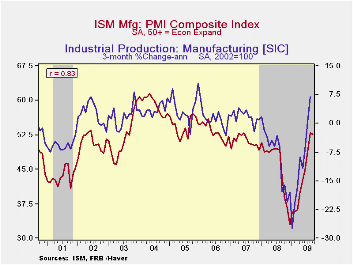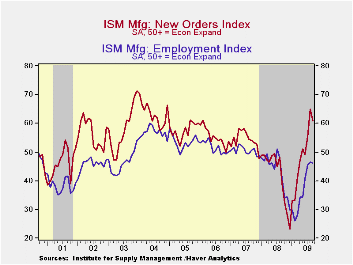 Global| Oct 01 2009
Global| Oct 01 2009ISM Factory Index Remains Near Highest Level Since Early-2007 Suggesting Positive Growth
by:Tom Moeller
|in:Economy in Brief
Summary
The National Association of Purchasing Management data continued to indicate that the recession in U.S. factory sector activity is over. Though the September composite index slipped to 52.6 from 52.9 in August, it remained near the [...]
 The National
Association of Purchasing Management data continued to indicate that
the recession in U.S. factory sector activity is over. Though the
September composite index slipped to 52.6 from 52.9 in August, it
remained near the highest level since June of 2007. (Any reading above
the break-even point of 50 suggests rising activity.) The latest figure
was up from the low of 32.9 hit last December but it fell short of
Consensus expectations for a reading of 54.0. The ISM data is available
in Haver's USECON database.
The National
Association of Purchasing Management data continued to indicate that
the recession in U.S. factory sector activity is over. Though the
September composite index slipped to 52.6 from 52.9 in August, it
remained near the highest level since June of 2007. (Any reading above
the break-even point of 50 suggests rising activity.) The latest figure
was up from the low of 32.9 hit last December but it fell short of
Consensus expectations for a reading of 54.0. The ISM data is available
in Haver's USECON database.
A sharp decline in
the production component to a still firm 55.7 accounted for much of the
latest decline. During the last ten years there has been an 84%
correlation between the level of the production component of the
composite index and the three-month growth in factory sector industrial
production.  It is appropriate to correlate the ISM index level
with factory sector output growth because the ISM
index is a diffusion index. It measures growth by using all of the
positive changes in activity added to one half of the zero change in
activity measures. The new orders component fell
just modestly. On the up side, the export order index at 55.0 was near
the highest in over a year, suggesting that recessions abroad are
winding down. During the last ten years there has been a 53%
correlation between the index and the q/q change in real exports of
goods in the GDP accounts.
It is appropriate to correlate the ISM index level
with factory sector output growth because the ISM
index is a diffusion index. It measures growth by using all of the
positive changes in activity added to one half of the zero change in
activity measures. The new orders component fell
just modestly. On the up side, the export order index at 55.0 was near
the highest in over a year, suggesting that recessions abroad are
winding down. During the last ten years there has been a 53%
correlation between the index and the q/q change in real exports of
goods in the GDP accounts.
The employment index also fell just slightly. Though the 46.2 reading continued to suggest a lower level of hiring, the index was near its highest level since last August and was up from the February low of 26.1. During the last ten years there has been a 90% correlation between the index level and the three-month change in manufacturing payrolls.
 A reduced rate of inventory
liquidation seems to be behind the factory sector's recent improvement.
The inventory index jumped to 42.5 which was its highest level since
last October. The speed of supplier deliveries also points toward
improvement in activity. Slower delivery speeds are indicated by a rise
in the index to its highest level since 2005 (no typo).
A reduced rate of inventory
liquidation seems to be behind the factory sector's recent improvement.
The inventory index jumped to 42.5 which was its highest level since
last October. The speed of supplier deliveries also points toward
improvement in activity. Slower delivery speeds are indicated by a rise
in the index to its highest level since 2005 (no typo).
The separate index of prices paid also suggests improved factory sector activity. At 63.5, the reading was near its highest level since last August and it's up from the December low of 18.0. During the last twenty years there has been a 79% correlation between the price index and the three-month change in the PPI for intermediate goods.
| ISM Mfg | September | August | September '08 | 2008 | 2007 | 2006 |
|---|---|---|---|---|---|---|
| Composite Index | 52.6 | 52.9 | 43.4 | 45.5 | 51.1 | 53.1 |
| New Orders Index | 60.8 | 64.9 | 39.2 | 42.1 | 54.3 | 55.4 |
| Employment Index | 46.2 | 46.4 | 40.9 | 43.2 | 50.5 | 51.7 |
| Prices Paid Index (NSA) | 63.5 | 65.0 | 53.5 | 66.5 | 64.6 | 65.0 |
Tom Moeller
AuthorMore in Author Profile »Prior to joining Haver Analytics in 2000, Mr. Moeller worked as the Economist at Chancellor Capital Management from 1985 to 1999. There, he developed comprehensive economic forecasts and interpreted economic data for equity and fixed income portfolio managers. Also at Chancellor, Mr. Moeller worked as an equity analyst and was responsible for researching and rating companies in the economically sensitive automobile and housing industries for investment in Chancellor’s equity portfolio. Prior to joining Chancellor, Mr. Moeller was an Economist at Citibank from 1979 to 1984. He also analyzed pricing behavior in the metals industry for the Council on Wage and Price Stability in Washington, D.C. In 1999, Mr. Moeller received the award for most accurate forecast from the Forecasters' Club of New York. From 1990 to 1992 he was President of the New York Association for Business Economists. Mr. Moeller earned an M.B.A. in Finance from Fordham University, where he graduated in 1987. He holds a Bachelor of Arts in Economics from George Washington University.






